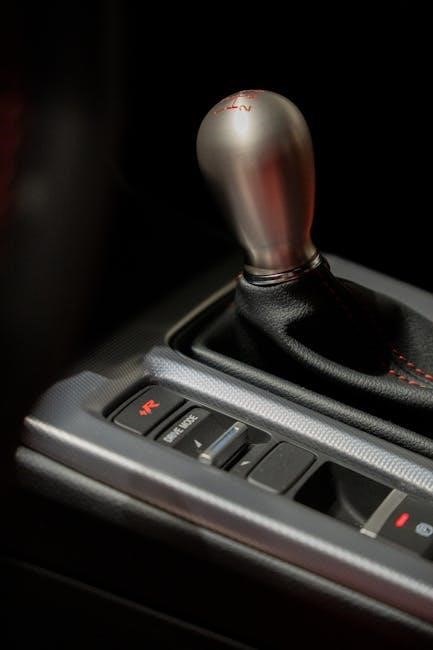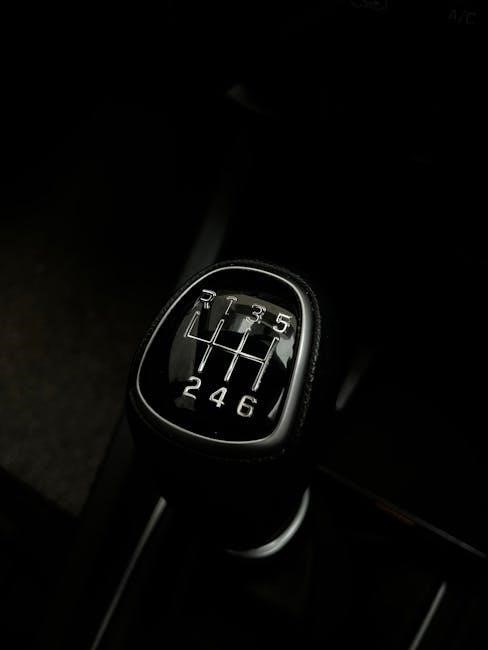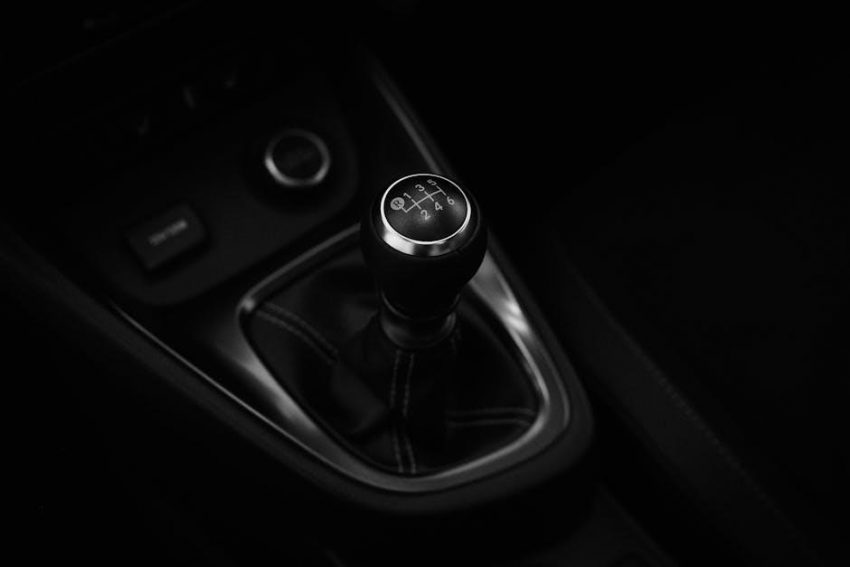The emergency brake, or parking brake, is a vital secondary braking system in manual transmission vehicles, ensuring safety and control, especially during emergencies or parking on inclines.
1.1 Definition and Purpose of the Emergency Brake
The emergency brake, commonly referred to as the parking brake, is a secondary braking system designed to secure a stationary vehicle, particularly on inclines. Engaging the emergency brake applies mechanical force to the rear wheels, preventing unintended movement. Unlike the primary braking system, it operates independently, offering an additional layer of safety. Its primary purpose is to ensure the vehicle remains stationary when parked, reducing the risk of accidental rolling. This mechanism is crucial for manual transmission vehicles, where it complements gear-based control and enhances overall stability and safety during emergencies or when parking.
1.2 Importance of the Emergency Brake in Manual Transmission Vehicles
The emergency brake plays a crucial role in manual transmission vehicles, offering an additional layer of control and safety. It prevents accidental rolling when parked, especially on slopes, and serves as a failsafe during primary brake failure. By engaging the rear wheels independently, it enhances stability and reduces strain on the transmission. Drivers can rely on it to maintain vehicle position during gear shifts or in emergency stops, ensuring smoother transitions and preventing potential skidding. Its importance extends to both urban and incline driving scenarios, making it an indispensable feature for manual transmission vehicles to ensure driver and passenger safety.

Mechanism and Design of the Emergency Brake
The emergency brake system uses a combination of levers, cables, and calipers to engage the rear wheels, providing a reliable secondary braking mechanism for manual transmission vehicles.
2.1 Overview of the Parking Brake System
The parking brake system, also known as the emergency brake, is a secondary braking mechanism designed to secure the vehicle when parked or in emergency situations. It operates independently of the primary braking system, typically engaging the rear wheels through a series of cables and levers activated by a hand or foot control. This system ensures the vehicle remains stationary, preventing accidental rolling. Modern systems may incorporate electronic components for enhanced functionality and ease of use.
2.2 Components of the Emergency Brake System
The emergency brake system consists of a control mechanism, such as a hand or foot lever, connected to a series of cables and actuators. These components engage the brake calipers or drum brakes on the rear wheels, securing the vehicle. The system also includes a release mechanism to disengage the brakes when needed. In modern vehicles, electronic parking brakes replace traditional cables with electric motors for smoother operation. Together, these parts ensure reliable functionality, preventing unintended movement and enhancing safety during emergencies or parking situations.
2.3 How the Emergency Brake Engages the Rear Wheels
When the emergency brake is activated, it engages the rear wheels by tightening cables connected to the brake calipers or drum brakes. Pulling the lever or pressing the pedal applies pressure, forcing brake pads or shoes against the rotors or drums. This direct mechanical connection ensures the rear wheels are securely locked, preventing movement. The system bypasses the primary braking circuit, providing a reliable backup. This engagement is crucial for maintaining vehicle stability during emergencies or when parked, especially on inclines, ensuring safety and control in critical situations.

Proper Usage of the Emergency Brake
The emergency brake is essential for securing the vehicle when parked and assisting in emergencies. Engage it smoothly to avoid sudden stops and ensure control while driving.
3.1 When to Use the Emergency Brake
The emergency brake is essential for securing the vehicle when parked, especially on inclines, to prevent accidental rolling. It should also be engaged during emergency stops if the primary braking system fails. Using the emergency brake gradually helps maintain control and prevents sudden skidding. Additionally, it is crucial for preventing unintended movement when parked, ensuring safety in various driving conditions. Proper usage enhances overall vehicle stability and driver confidence, making it a vital component in both everyday parking and critical emergency situations.
3.2 How to Engage and Release the Emergency Brake
To engage the emergency brake, pull the lever upward or press the pedal firmly, ensuring it locks in place. For manual systems, this action applies force to the rear wheels. Modern vehicles may use electronic switches for easier operation. To release, push the lever down or press the switch while holding the brake pedal. Some systems require the ignition to be on for electronic release. Always engage and release smoothly to avoid sudden jolts. Proper technique ensures safe and effective use of the emergency brake in both manual and electronic configurations.
3.3 Using the Emergency Brake in Emergency Situations
In emergency situations, the emergency brake serves as a critical secondary braking system. If the primary brakes fail, engaging the emergency brake can help bring the vehicle to a safe stop. Pull the lever firmly or press the switch to activate it gradually, avoiding sudden stops that could cause skidding. For manual transmissions, using the emergency brake in conjunction with downshifting can enhance control. It is especially useful on inclines or when transmission issues arise. Always engage the brake smoothly and hold it to maintain stability and prevent unintended movement during emergencies.

Maintenance and Inspection of the Emergency Brake
Regular inspection of the emergency brake ensures proper functionality. Check the brake cable for wear, adjust brake shoes, and replace worn pads to maintain reliability and safety.
4.1 Regular Checks for the Parking Brake System
Regular checks for the parking brake system are essential to ensure reliability. Inspect the brake cable for frays or damage, and test the brake lever’s resistance. Adjust the cable tension if it feels loose or overly tight. Additionally, check the brake pads and shoes for wear, as worn components can reduce braking effectiveness. Lubricate moving parts to prevent corrosion and ensure smooth operation. These checks help maintain the parking brake’s functionality, crucial for safety, especially in manual transmission vehicles where the system complements gear shifts and prevents unintended movement.
4.2 Common Issues with the Emergency Brake
Common issues with the emergency brake include worn brake pads or shoes, loose or stretched brake cables, and corrosion on mechanical components. Over time, the brake cable may lose tension, reducing effectiveness. Corrosion can seize brake parts, especially in harsh weather conditions. Additionally, electronic parking brake systems may experience sensor or motor malfunctions. Drivers should also watch for warning lights on the dashboard indicating system faults. Addressing these issues promptly ensures reliable operation and safety, particularly in manual transmission vehicles where the emergency brake plays a critical role in securing the vehicle when parked or during emergencies.
4.3 Troubleshooting Tips for the Emergency Brake
- Check the brake fluid level, as low levels can affect brake performance and trigger warning lights.
- Inspect the brake cable for damage or stretching, ensuring proper tension for effective braking.
- Examine brake pads or shoes for wear and replace them if necessary to maintain consistent stopping power.
- Look for corrosion on mechanical components, especially in harsh weather conditions, and clean or replace parts as needed.
- For electronic parking brakes, check sensor functionality and ensure the system is calibrated correctly.
- If issues persist, consult a professional mechanic to diagnose and repair complex problems.

Role of the Emergency Brake in Driving Safety
The emergency brake is essential for preventing accidental rolling, aiding in emergency stops, and enhancing control on inclines, ensuring safer driving in manual transmission vehicles.
5.1 Preventing Accidental Rolling of the Vehicle
The emergency brake plays a crucial role in preventing accidental rolling of the vehicle, especially on inclines or uneven surfaces. By engaging the rear wheels, it ensures the car remains stationary, reducing the risk of unintended movement. This is particularly important for manual transmission vehicles, where rolling can occur if the clutch is disengaged improperly. Proper use of the emergency brake provides an additional layer of safety, ensuring the vehicle stays in place even when parked on steep hills. This feature enhances overall driving safety and prevents potential accidents caused by vehicle movement.
5.2 Assisting in Emergency Stops
The emergency brake serves as a critical auxiliary system during emergency stops, providing additional stopping power when needed. By engaging the rear wheels independently of the primary braking system, it helps stabilize the vehicle and reduce stopping distance. In situations where the main brakes fail or lose effectiveness, the emergency brake offers a reliable backup option. Its direct mechanical linkage ensures immediate response, enhancing control and safety. This feature is particularly valuable in manual transmission vehicles, where precise braking and gear control are essential. Using the emergency brake judiciously can prevent skidding and maintain stability, making it a vital component in emergency maneuvers.
5.3 Enhancing Control on Inclines
The emergency brake plays a pivotal role in maintaining vehicle stability on inclines, especially in manual transmission vehicles. By engaging the rear wheels, it prevents the car from rolling unintentionally when parked or during hill starts. This added control is crucial for driver confidence, particularly on steep slopes. The emergency brake works in tandem with the manual transmission’s gear system, allowing drivers to secure the vehicle’s position without relying solely on the clutch or foot brake. Its ability to lock the rear wheels ensures enhanced stability, making it an essential feature for safe maneuvering on uneven terrain;

Relationship Between the Emergency Brake and Manual Transmission
The emergency brake complements manual transmissions by enhancing control, preventing vehicle roll on inclines, and reducing transmission strain during hill starts and sudden stops.
6.1 How the Emergency Brake Complements Manual Gear Shifts
The emergency brake enhances manual transmission driving by providing an additional control layer. It prevents the vehicle from rolling during gear changes, especially on inclines, allowing smoother transitions between gears. By engaging the emergency brake, drivers can avoid unintended movement, reducing strain on the clutch and gearbox. This synergy between manual shifting and the emergency brake ensures precise control, particularly in challenging conditions like steep hills or sudden stops. It acts as a safety net, giving drivers confidence in their ability to manage the vehicle effectively.
6.2 Preventing Transmission Strain with Proper Brake Usage
Proper use of the emergency brake is crucial for preventing strain on the manual transmission. By engaging the emergency brake, especially on inclines or during sudden stops, drivers can reduce the load on the transmission system. This prevents excessive wear on components like the clutch and gearbox. Improper brake usage, such as riding the brake or failing to engage it fully, can lead to unnecessary stress on the transmission. Using the emergency brake correctly ensures smoother operation and extends the lifespan of the vehicle’s drivetrain, maintaining optimal performance and reliability over time.

Modern Advancements in Emergency Brake Technology
Modern emergency brake systems now feature electronic parking brakes and automatic engagement, enhancing safety and convenience. These advancements reduce mechanical components and improve reliability in modern vehicles.
7.1 Electronic Parking Brake Systems
Electronic parking brake systems replace traditional manual levers with digital controls, enhancing convenience and reliability. These systems use electric motors to engage the brakes, eliminating the need for cables. They offer features like automatic engagement and release, reducing driver effort. Modern vehicles often combine these systems with other safety technologies, improving overall braking performance. Electronic parking brakes also reduce mechanical components, minimizing maintenance. They can be activated independently of the main braking system, providing an additional layer of safety. This technology is particularly beneficial in emergency situations, offering quick and precise control over the vehicle’s stopping mechanism.
7.2 Automatic Engagement Features
Modern vehicles now feature automatic engagement for the emergency brake, enhancing safety and convenience. These systems can activate the brake without manual intervention, especially when the vehicle is stationary or in emergency situations. Some cars automatically engage the parking brake when the ignition is turned off or when the driver’s seatbelt is unbuckled. This feature is particularly useful in preventing accidental rolling and ensuring the vehicle remains secure. Automatic engagement also integrates with other safety technologies, such as brake hold systems, to provide seamless functionality. This innovation reduces driver effort and enhances overall vehicle safety, making it a valuable advancement in emergency brake technology.

Common Myths and Misconceptions
Many believe the emergency brake is only for hills or manual transmissions, but it serves all vehicles, ensuring safety and preventing rolls in various conditions.
8.1 Myths About the Emergency Brake and Its Usage
A common myth is that the emergency brake is only necessary for manual transmissions or hill parking. However, it is essential for all vehicles to prevent unintended movement. Many drivers believe the emergency brake is redundant with modern braking systems, but it serves as a critical failsafe. Another misconception is that the emergency brake should only be used in emergencies, when in fact, it is designed for regular parking situations. Some think engaging it slightly can damage the system, but proper use ensures safety without harm. Understanding these myths promotes correct usage and enhances overall vehicle safety.
8.2 Debunking Misconceptions About the Parking Brake
One misconception is that the parking brake is only for emergencies, but it is primarily designed to secure the vehicle when parked. Many believe manual transmissions don’t need it, but it prevents rolling and reduces transmission strain. Another myth is that engaging the parking brake gradually can damage the system, when in fact, gradual engagement is safe and effective. Some think modern electronic parking brakes are less reliable than manual ones, but they offer consistent performance and added features like automatic engagement. Understanding these truths ensures proper usage and enhances driving safety and vehicle longevity.

Legal and Safety Regulations
Laws mandate functional emergency brakes to ensure vehicle safety and prevent unauthorized movement, with specific standards for design, testing, and compliance to protect drivers and road users.
9.1 Legal Requirements for Emergency Brake Systems
Legal regulations mandate that all vehicles, including manual transmission ones, must have a functional emergency brake system. These laws ensure the brake meets specific safety standards, such as reliably holding the vehicle stationary on inclines and preventing unintended movement. Compliance with these requirements is enforced through inspections and certifications. Failure to meet standards can result in legal penalties, fines, or vehicle registration denial. Proper installation, testing, and maintenance of the emergency brake are critical to avoid violations and ensure road safety. Authorities rigorously monitor adherence to these regulations to protect public safety and prevent accidents caused by faulty braking systems.
9.2 Safety Standards for Parking Brake Functionality
Safety standards for parking brake functionality ensure the system can securely hold a vehicle on inclines and prevent unintended movement. These standards, set by regulatory bodies like FMVSS and UN ECE, mandate minimum performance criteria, including maximum braking force and wear limits. Testing protocols verify the brake’s ability to hold the vehicle under various conditions. Fail-safe mechanisms and redundancy are also required to prevent complete system failure. Compliance ensures the parking brake operates reliably, enhancing vehicle safety and reducing accident risks. Regular inspections and maintenance are essential to meet these standards and maintain optimal functionality over time.
The emergency brake is a critical safety feature in manual transmission vehicles, ensuring control and preventing accidents. Proper usage and maintenance are essential for optimal functionality and safety.
10.1 Summary of Key Points
The emergency brake is a critical secondary braking system in manual transmission vehicles, designed to ensure safety and control. It prevents accidental rolling, assists in emergency stops, and enhances control on inclines. Proper usage involves engaging it gradually, especially on slopes, and releasing it smoothly. Regular maintenance, including cable checks and adjustments, is essential for reliability. Modern advancements like electronic parking brakes offer improved functionality. Understanding its role and legal requirements ensures compliance and safety. By mastering its use, drivers can prevent transmission strain and maintain control in various driving conditions, making it an indispensable feature for safe and efficient driving;
10.2 Final Thoughts on the Importance of the Emergency Brake
The emergency brake is a cornerstone of safety in manual transmission vehicles, providing an additional layer of control and security. Its ability to prevent accidental rolling and assist in emergency stops makes it indispensable. Proper usage and maintenance ensure reliability, while modern advancements enhance its functionality. Whether parking on inclines or addressing unexpected situations, the emergency brake offers peace of mind. Understanding its role and integrating it into driving habits is essential for safe and efficient driving. Its significance extends beyond mere convenience, making it a vital component for every driver to master and appreciate.

Additional Resources
Explore manufacturer manuals, online tutorials, and automotive guides for deeper insights into emergency brake systems in manual transmissions. These resources offer practical tips and technical details for optimal usage.
11.1 Recommended Reading for Further Learning
For a deeper understanding, explore resources like “Manual Transmission Maintenance” by John Smith and “Advanced Driving Techniques” by Auto Experts. Online forums such as CarEnthusiast.net and tutorials on YouTube channels like AutoTech offer practical insights. Manufacturer-specific manuals, such as those from Toyota and Ford, provide detailed instructions tailored to your vehicle; Additionally, guides like “The Art of Driving” by DrivingPro and “Car Care Essentials” by MechanicMaster are excellent for comprehensive learning. These resources cover troubleshooting, optimal usage, and advanced safety tips for emergency brakes in manual transmissions.
11.2 Manufacturer Guidelines and Manuals
Consulting your vehicle’s manufacturer guidelines and manuals is essential for understanding the emergency brake system. Most manufacturers, like Toyota and Ford, provide detailed instructions on proper usage, maintenance, and troubleshooting. These manuals often include specific procedures for engaging and releasing the emergency brake, especially in emergency situations; Additionally, many manufacturers offer online resources and updated manuals for modern systems, such as electronic parking brakes. Always refer to your vehicle’s specific manual to ensure compliance with manufacturer recommendations and safety standards. This ensures optimal functionality and prevents potential issues with your manual transmission and braking system.
